Cuesta College, San Luis Obispo, CA
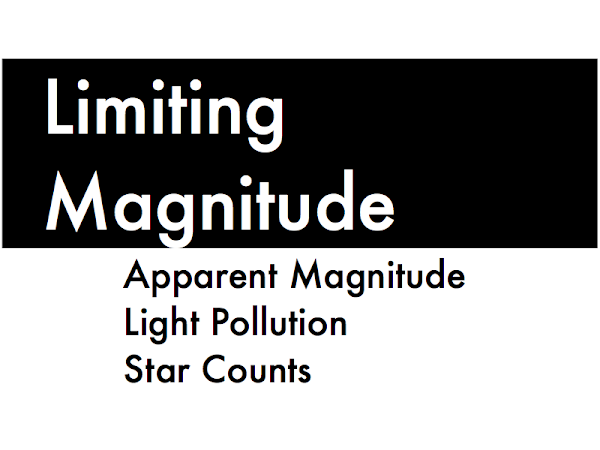 (This is the second Astronomy 210L laboratory at Cuesta College, San Luis Obispo, CA. This course is a one-semester, optional adjunct laboratory to the Astronomy 210 introductory astronomy lecture, taken primarily by students to satisfy their general education science transfer requirement.)
(This is the second Astronomy 210L laboratory at Cuesta College, San Luis Obispo, CA. This course is a one-semester, optional adjunct laboratory to the Astronomy 210 introductory astronomy lecture, taken primarily by students to satisfy their general education science transfer requirement.)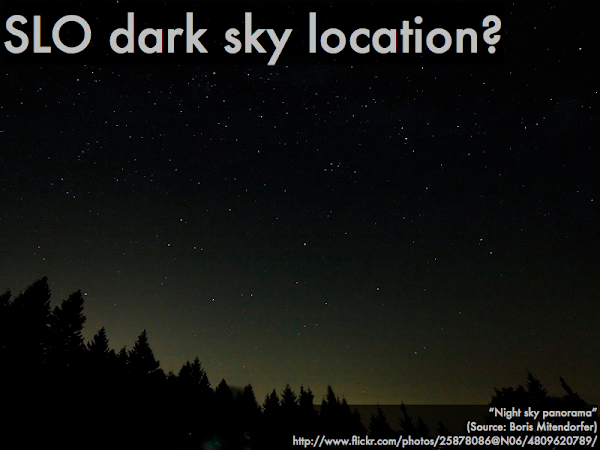 So where would you go in San Luis Obispo county to find the darkest skies available?
So where would you go in San Luis Obispo county to find the darkest skies available?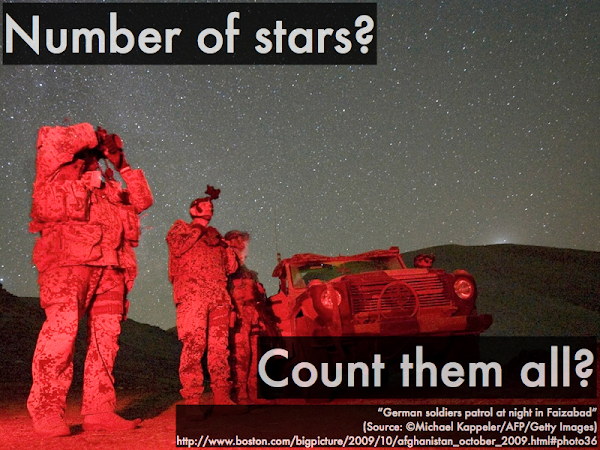 ...and once you were there, let's say you were so impressed by the sheer number of stars that you wanted to count them all.
...and once you were there, let's say you were so impressed by the sheer number of stars that you wanted to count them all.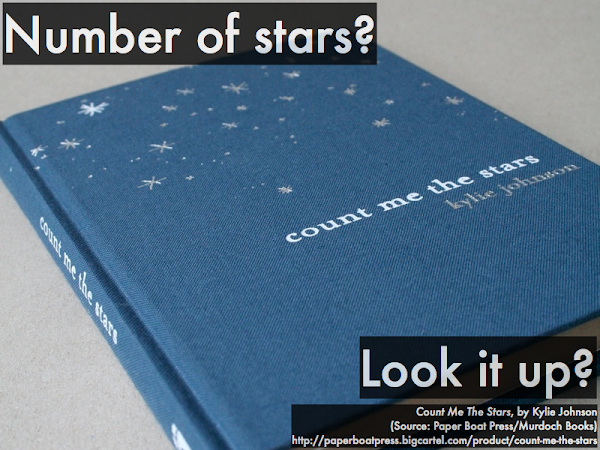 Maybe not--you might be able to look up the expected number of stars in a dark sky.
Maybe not--you might be able to look up the expected number of stars in a dark sky. Or better yet, let's consider a systematic approach where you can count the number of stars on and within a certain part of the sky (the "Orion's Torso" asterism), and then be able to extrapolate this count to the total number of stars in the rest of the sky.
Or better yet, let's consider a systematic approach where you can count the number of stars on and within a certain part of the sky (the "Orion's Torso" asterism), and then be able to extrapolate this count to the total number of stars in the rest of the sky.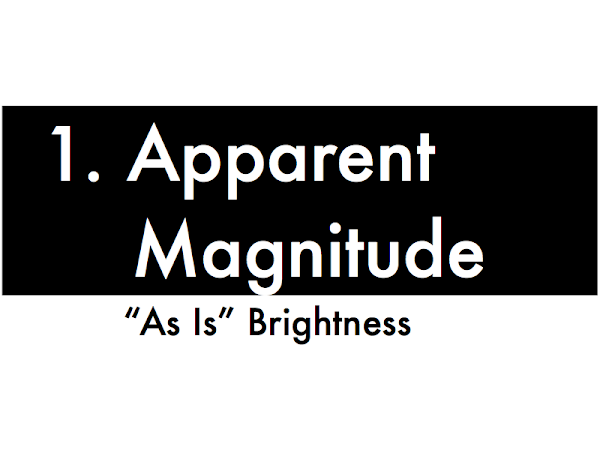 First, let's consider how to rate the brightness of a star. This is not the same thing as the "true" brightness of a star, just how bright a star is as it appears in the our sky. (So yes, our sun, a rather mediocre brightness star "cheats" because it happens to be very close, so that's why we talk about its "apparent" magnitude being bright in comparison to the rest of the stars that we can see from Earth.)
First, let's consider how to rate the brightness of a star. This is not the same thing as the "true" brightness of a star, just how bright a star is as it appears in the our sky. (So yes, our sun, a rather mediocre brightness star "cheats" because it happens to be very close, so that's why we talk about its "apparent" magnitude being bright in comparison to the rest of the stars that we can see from Earth.)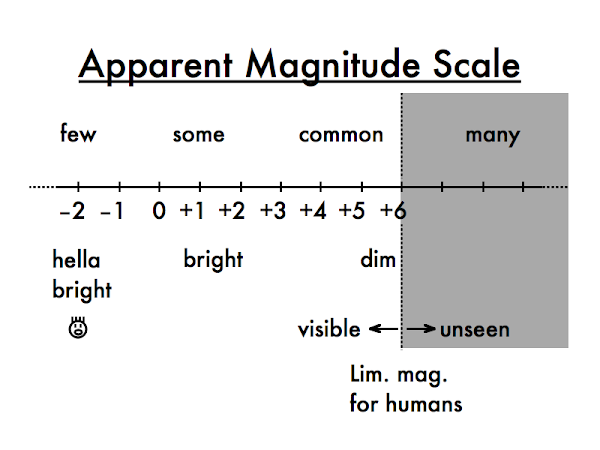 The original Greek scale has +1 for the brightest stars, and +6 for the dimmest stars. If the smaller number for brighter stars bothers you, think of ranking schemes (as did the Greeks), where the brightest stars were "first place" or "top tier" stars, and the dimmest stars are in "sixth place," earning the Miss Congeniality prize. And the scale did need to get revised, as there a few stars that blow the top off the original +1 to +6 scale. Brighter than the "first place" +1 stars are "zero place" stars, and brighter than those stars are "-1 place" stars. These are the hella bright stars--at least, for those astronomers who come from Northern California. There are also lots of stars dimmer than +6, but due to the limitation of the human eye these cannot be seen with the naked eye, even under the best of circumstances, but these stars can easily be observed with telescopes or even decent binoculars.
The original Greek scale has +1 for the brightest stars, and +6 for the dimmest stars. If the smaller number for brighter stars bothers you, think of ranking schemes (as did the Greeks), where the brightest stars were "first place" or "top tier" stars, and the dimmest stars are in "sixth place," earning the Miss Congeniality prize. And the scale did need to get revised, as there a few stars that blow the top off the original +1 to +6 scale. Brighter than the "first place" +1 stars are "zero place" stars, and brighter than those stars are "-1 place" stars. These are the hella bright stars--at least, for those astronomers who come from Northern California. There are also lots of stars dimmer than +6, but due to the limitation of the human eye these cannot be seen with the naked eye, even under the best of circumstances, but these stars can easily be observed with telescopes or even decent binoculars.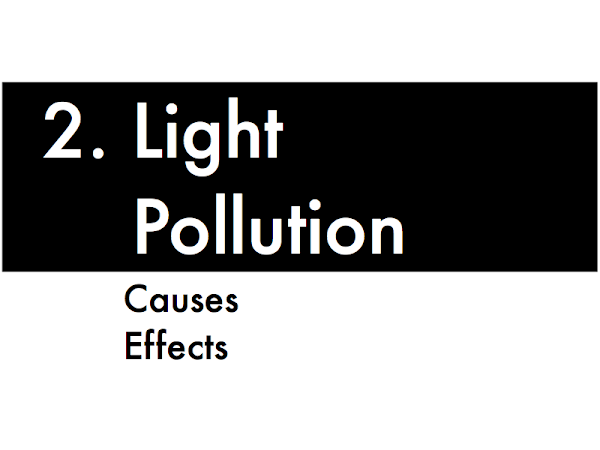
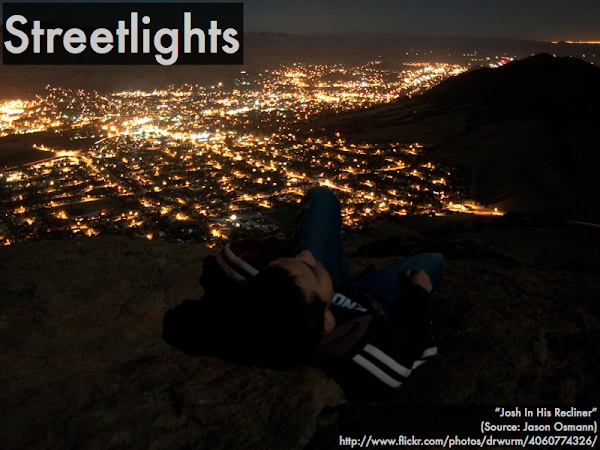 Streetlights cause light pollution. However, the other part of this effect is the atmosphere itself, as stuff in the air reflects the upward light back down towards our eyes, making it difficult to see the stars. And light pollution is not all manmade--the moon also does its damage as well.
Streetlights cause light pollution. However, the other part of this effect is the atmosphere itself, as stuff in the air reflects the upward light back down towards our eyes, making it difficult to see the stars. And light pollution is not all manmade--the moon also does its damage as well. So compare this view seen from a dark sky location (here seen through a telescope, so there are lots of stars much dimmer than +6 visible, as well as nebulae)...
So compare this view seen from a dark sky location (here seen through a telescope, so there are lots of stars much dimmer than +6 visible, as well as nebulae)... ...with the same part of the sky, seen with the skyglow of downwards reflected streetlight. The dim stars disappear, and even the brighter stars are harder to make out.
...with the same part of the sky, seen with the skyglow of downwards reflected streetlight. The dim stars disappear, and even the brighter stars are harder to make out.So instead of the naked eye being limited to seeing stars +6 and brighter, light pollution shifts the limiting magnitude to the left.
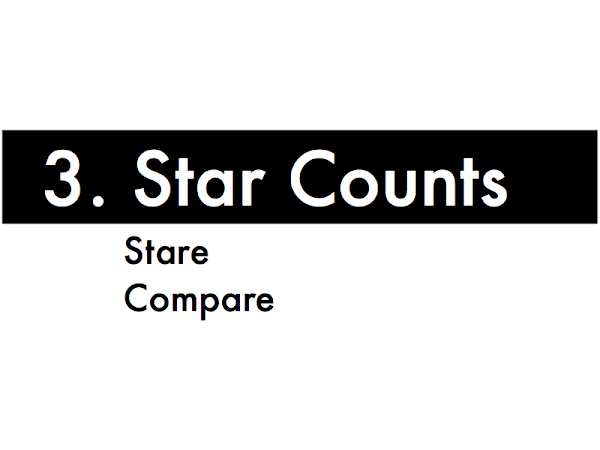 Let's now get to the process of counting stars within a representative, manageable portion of the sky, in order to extrapolate this to find the total stars in the rest of the sky.
Let's now get to the process of counting stars within a representative, manageable portion of the sky, in order to extrapolate this to find the total stars in the rest of the sky. 

 Each group will pick up a packet of star charts showing Orion's Torso under dark, suburban, and urban conditions. Consider this training for actually doing this observation in the night sky.
Each group will pick up a packet of star charts showing Orion's Torso under dark, suburban, and urban conditions. Consider this training for actually doing this observation in the night sky.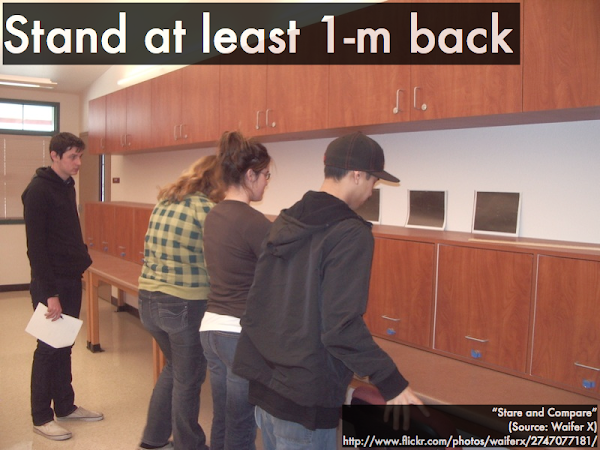 You can't touch the stars with your fingers...no way, nuh-uh. So you need to stand at least 1 m back from the charts, and count these stars in your head, in order to simulate the approximate conditions for counting stars at night. Count stars on the border as well as inside Orion's Torso, compare results with your group members (you might even discover a "secret star" or two!), and determine the average number of stars within Orion's Torso for each light pollution condition.
You can't touch the stars with your fingers...no way, nuh-uh. So you need to stand at least 1 m back from the charts, and count these stars in your head, in order to simulate the approximate conditions for counting stars at night. Count stars on the border as well as inside Orion's Torso, compare results with your group members (you might even discover a "secret star" or two!), and determine the average number of stars within Orion's Torso for each light pollution condition. The "Orion's Torso Stars, Ranked by Apparent Magnitude" table lists the stars from brightest to dimmest apparent magnitudes. If say, your group had counted an average of 22 stars under certain lighting conditions, then you look up the 22nd brightest star in Orion's Torso, and since it has an apparent magnitude of +4.93, this is the limiting magnitude for those lighting conditions--you can see all stars +4.93 and brighter, and can't see stars dimmer than +4.93.
The "Orion's Torso Stars, Ranked by Apparent Magnitude" table lists the stars from brightest to dimmest apparent magnitudes. If say, your group had counted an average of 22 stars under certain lighting conditions, then you look up the 22nd brightest star in Orion's Torso, and since it has an apparent magnitude of +4.93, this is the limiting magnitude for those lighting conditions--you can see all stars +4.93 and brighter, and can't see stars dimmer than +4.93. Now use the "Number of Celestial Sphere Stars versus Limiting Magnitude" graph. With our example of a limiting magnitude of +4.93 in Orion's Torso, draw a line vertically upwards until you hit this diagonal, and then go horizontally and read off the corresponding number of stars in the entire celestial sphere under these lighting conditions. Here, approximately 1,600 stars.
Now use the "Number of Celestial Sphere Stars versus Limiting Magnitude" graph. With our example of a limiting magnitude of +4.93 in Orion's Torso, draw a line vertically upwards until you hit this diagonal, and then go horizontally and read off the corresponding number of stars in the entire celestial sphere under these lighting conditions. Here, approximately 1,600 stars.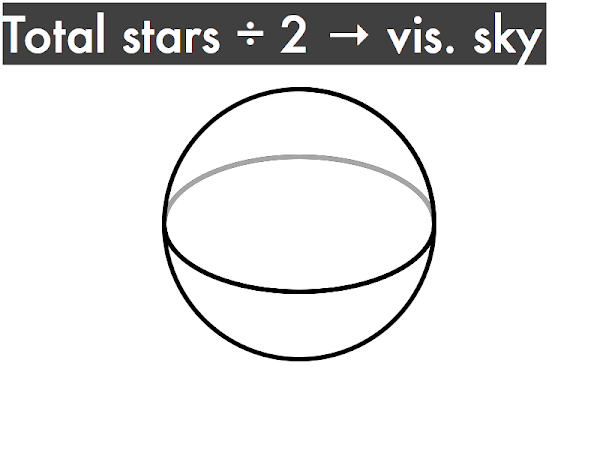
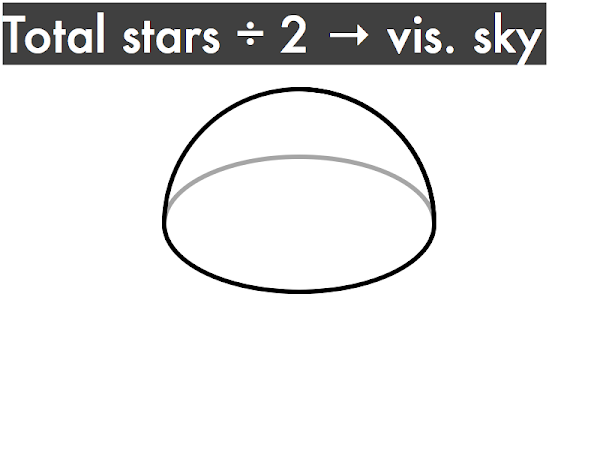 But since this 1600 is the stars in the entire celestial sphere, and you can only see half of the celestial sphere above the horizon at any given time, then under these lighting conditions (22 stars in Orion's Torso, limiting magnitude +4.93), there would be expected to be only 1600/2 = 800 stars in the night sky.
But since this 1600 is the stars in the entire celestial sphere, and you can only see half of the celestial sphere above the horizon at any given time, then under these lighting conditions (22 stars in Orion's Torso, limiting magnitude +4.93), there would be expected to be only 1600/2 = 800 stars in the night sky.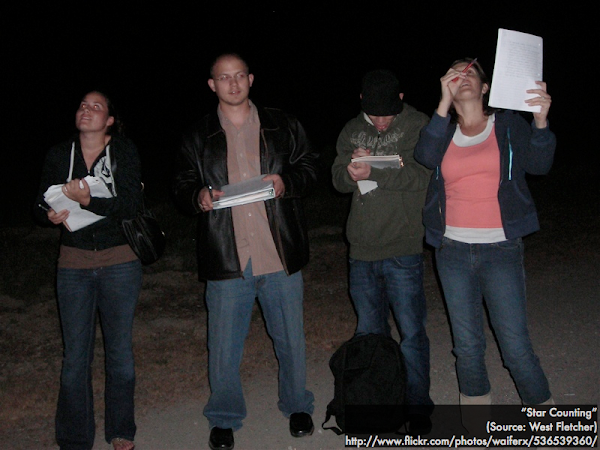 After completing this laboratory, you should then be successfully trained star counters, and can find the limiting magnitude (and total number of visible stars in the sky) at various locations around San Luis Obispo county. Good times.
After completing this laboratory, you should then be successfully trained star counters, and can find the limiting magnitude (and total number of visible stars in the sky) at various locations around San Luis Obispo county. Good times.EQUIPMENT
Cuesta ThinkPad(TM) laptops (wireless networking, internet browser)
(appropriate, responsible in-class use of personal laptops allowed)
Orion's Torso light pollution star charts
"Orion's Torso Stars, Ranked by Apparent Magnitude" table
"Number of Celestial Sphere Stars versus Limiting Magnitude" graph
meter sticks (1 m)
rulers
CURRENT EVENTS QUIZ
(First 10 minutes of laboratory.)
BRIEFING
Limiting Magnitude (*.pdf) (*.mov)
BIG IDEA
Star brightnesses in the night sky are quantified by (apparent) magnitudes; man-made (and moon) light pollution limits the stars that can be seen with the naked eye.
GOAL
Students will conduct a series of inquiries about the magnitudes of stars using printed-out simulations of key asterisms, and be able to locate these asterisms using internet simulations and in the night sky for potential observations.
COMPUTER SETUP
Access the Heavens Above website for your campus by clicking on the appropriate link below, and then select "Astronomy > Sky Chart":
*Bowen Observatory, San Luis Obispo campus (*.html)
*Telescope shelter, North County campus (*.html)
You should now see a star chart for the current time/date, where north is at the top, and west is to the right.
TASKS
1. Exploration
"Orion's Torso" is not a true constellation, but an asterism made up of the brightest stars of the central part of the constellation Orion. You will determine when Orion's Torso will be highest overhead on the next available moon-less night. Then you will simulate counting the visible stars on and inside Orion's Torso, in order to determine the limiting magnitude, and the total number of visible stars in the sky.
a. Advance the time such that Orion's Torso is highest overhead tonight. If the sun and/or moon is visible anywhere in the sky, you will need to advance the date and adjust the time to find a moon-less date/time later this semester, within the next month or so when Orion's Torso is highest overhead at night. Record the following date/time below:
Available moon-less night within next month or so: __________.
Orion's Torso highest overhead time (to within +/- 10 min): __________.
b. Use a meter stick to space yourself at least 1.0 meter away from charts showing Orion's Torso under various conditions (dark sky, suburban sky, and urban sky). Count the number of stars visible on or within Orion's Torso (include the "corner stars"). Do this individually first, then determine the average result in your group for each viewing condition.
Dark sky average count: __________.
Suburban sky average count: __________.
Urban sky average count: __________.
c. Refer to the "Orion's Torso Stars, Ranked by Apparent Magnitude" table, which lists Orion's Torso stars, ranked from brightest to dimmest, along with the value of their apparent magnitude, denoted by m. List the names of Orion's Torso stars (if any) that are brighter than Polaris (the "North Star," a +2.00 magnitude star).
Stars brighter than Polaris in Orion's Torso (if any): __________.
d. The limiting magnitude corresponds to the dimmest star that can be seen under given viewing conditions. Using the "Orion's Torso Stars, Ranked by Apparent Magnitude" table, determine the average limiting magnitude value for your group for each viewing condition.
Dark sky limiting magnitude: __________.
Suburban sky limiting magnitude: __________.
Urban sky limiting magnitude: __________.
e. Refer to the "Number of Celestial Sphere Stars versus Limiting Magnitude" graph, which allows you to look up the total number N of visible stars in the entire celestial sphere, given a limiting magnitude from +1.00 to +6.00. (Divide N by two to get the number of visible stars in the sky, as it is only possible to see half of the entire celestial sphere at any given time.) From your limiting magnitudes in (d), use this graph to determine the total number of visible stars in the sky for each viewing condition.
Dark sky visible stars: __________.
Suburban sky visible stars: __________.
Urban sky visible stars: __________.
f. What generalization statements, in a complete sentences, can you make about (1) how the limiting magnitude changes with respect to light pollution; and (2) how the number of visible stars in the sky changes with respect to light pollution?
Generalization statements: __________.
Each person in your group should summarize their own Exploration answers, to be turned in today and selected randomly to be graded for their group(*).
2. Does Evidence Match a Given Conclusion?
Consider the following claim:
"In the center of a city, where the naked-eye limiting magnitude due to extreme amounts of light pollution can be [+4] or less, as few as 200 to 500 stars are visible [in the sky]."Would you agree or disagree with this generalization based on the methods/evidence used in the previous task? Explain your reasoning and provide specific evidence from data to support your reasoning(*).
--http://en.wikipedia.org/wiki/Naked_eye
3. What Conclusions Can You Draw From This Evidence?
Due to campus streetlights, and from the neighboring Camp San Luis Obispo and the California Men's Colony, the Bowen Observatory on the roof of Building 2400 on the San Luis Obispo campus experiences a certain amount of light pollution.
What conclusions and generalizations can you make from data collected by Cuesta College Astronomy 210L students in spring 2006-2010 in terms of "Does the Bowen Observatory experience light pollution comparable to other suburban areas in San Luis Obispo county?"
| Location: | Orion's Torso stars: |
| Morro Bay | 27 |
| South San Luis Obispo | 40 |
| Creekside Farms, Paso Robles | 21 |
| San Miguel | 19 |
| Santa Margarita | 35 |
| Morro Bay | 23 |
| Central San Luis Obispo | 19 |
| Central San Luis Obispo | 17 |
| Bishop's Peak | 30 |
| Just off Cal Poly campus | 25 |
| Cal Poly campus | 23 |
| Templeton | 20 |
| Bowen Observatory | 14, 13, 19, 17, 16, 17 |
Explain your reasoning and provide specific evidence to support your reasoning(*).
4. What Evidence Do You Need to Pursue?
Describe precisely what evidence you would need to collect in order to answer the research question of, "Is there more or less light pollution at the star party location on the North County campus (at the Telescope Shelter) than at the Bowen Observatory on the San Luis Obispo campus (Building 2400)?" You do not need to actually complete the steps in the procedure you are writing.
Create a detailed, step-by-step description of evidence that needs to be collected and a complete explanation of how this could be done--not just "Drive to each location and count stars," but exactly what would someone need to do, step-by-step, to accomplish this. You might include a table and sketches--the goal is to be precise and detailed enough that someone else could follow your procedure by simply checking off each step, without having to "interpret" the instructions(*). (Note: be sure to specify a moon-less date/time at least one week from today that these observations can be made.) Write up your procedure on whiteboards(*), to be worked on and presented as a group.
Reference:
- Tim Slater, Stephanie Slater, Daniel J. Lyons, Engaging in Astronomical Inquiry, W.H. Freeman & Company, New York, 2010,
http://www.whfreeman.com/newcatalog.aspx?disc=Astronomy+%26+Physics&course=Introduction+to+Astronomy&isbn=1429258608.

4 comments:
Astronomy 210L, Spring Semester 2011
Cuesta College, San Luis Obispo, CA
Online post-lab assignment 1
Discuss the most interesting aspect of this lab, and explain why this was personally interesting for you.
The following are a sampling of the student responses to this question, verbatim and unedited.
"The most interesting aspect of this lab was finding out the process of discovering the number of stars visible in the night's sky. I appreciated this the most because I have a deep fascination for astronomy, and enjoy using information like this."
"Most interesting aspect for me is to see exactly how much light pollution can effect the human eye's visibility of the stars at night. Growing up you always know that you can see more stars in remote locations (like when camping) than you can at home (in cities, suburbs, etc.) but you never really grasp exactly why. It was fun to learn why that is, and get a hands-on experience with calculating it."
"the most interesting aspect of this lab was learning how stars are characterized by their brightness. Also, learning how to tell how many stars would be visible on a given night by doing only a few steps."
"Learning that light pollution can prevent someone from seeing stars was interesting. I thought if it was hard to see stars at night it was only from air pollution."
"The most interesting aspect of this lab was learning a more practical way to count the stars in the sky. It was personally interesting to me because I have often found myself guessing at the number of stars that one can see in the sky."
"I found learning what Orion's Torso looks like was the most interesting. On Tuesday night I found it in the sky for the first time."
"The most interesting aspect of this lab was seeing the difference between the different areas and how they are affected by light pollution. I've always wondered why I can see more stars when I'm away from light rather than closer."
"I didn't realize there was such a huge difference in visible stars in a light-polluted area. How tragic for people living in big cities!"
"I found it was interesting counting the stars on the pictures of the stars in the Orion constellation. I thought it was interesting because it was amazing to see the difference in the amount of stars your eyes can pick up between areas of high light pollution and low light pollution."
"The most interesting aspect of this lab, for me, was discovering when was the best time to 'star gaze.' I didn't realize that the Orien had to be directly overhead, and that the moon was not supposed to be out."
"My favorite part of the lab was counting the stars from a meter away. I liked it because I like getting out of my seat and doing somthing."
"I found the ability to determine the amount of visible stars in a specific constellation at any given moment most interesting. As a person who enjoys math its nice to be able to get an answer even if its a rough estimate."
"I didn't realize we got suburban light pollution in North and South county. It shows how suburban sprawl really is noticeable in SLO County and especially in San Luis Obispo. I find it interesting as I'm a city planning major."
"It was interesting to find out that there might only be 35 visible stars in the urban areas :("
"To me the most interesting part of the lab was seeing the effects of light pollution with the stars in the constellation Orion. This is interesting to me because my dad and I are huge astronomy people and he has had some of his photograph published in Astronomy Magazine. Light pollution affects us when we want to look at the night sky. Although where we live the fog and clouds is what we fight with the most."
"My favorite part of the lab was converting everything with the charts. I like using charts and tables to back up my findings."
Astronomy 210L, Spring Semester 2011
Cuesta College, San Luis Obispo, CA
Online post-lab assignment 1
Discuss the most confusing aspect of this lab, and explain why this was personally confusing for you.
The following are a sampling of the student responses to this question, verbatim and unedited.
"The most confusing aspect was probably finding the limited magnitude and using it to calculate how many stars you could see from different locations with different light pollutions. It's not that the task itself was confusing, it just took some time to sort through and organize the information the first time around."
"i thought it was to count all the stars on the page at first I counted 86 stars but ealized i countd the page"
"while i find this interesting i was getting confused a little on which stars to count, like should the ones on the line be counted? "
"The most confusing part of the lab was trying to remember that the numbers went from +1 as the brightest and +6 as the least brightest, while trying to keep that in mind when calculating the information. "
"The first part where we had to manipulate the years, months, days, hours and minutes to find the next moon-less night. I didn't understand the entire point, and it seemed like it had no correct answer."
"I find 'apparent visual magnitude' to be a little awkward. This is because a star count becomes dependent upon an individuals ability to see clearly. I, with my poor vision, would have a differant star count then a person with 20/20 vision. But I still think this method is really cool."
"The confusing part of the lab was matching up the highest point of Orion's torso with the new moon. Personally it was neat to see how the constellations move through out the night and at what times."
"I did not find this lab very confusing. Astronomy, for me, always has that 'click' moment where it all makes sense when only minutes earlier it was gibberish."
"The most confusing part was writing out the last question for the lab. It was confusing because there were a lot of small parts you had to list, that played a roll in the answer."
"I think the most confusing part for me was answering some of the lab questions, like the one where we had to prove of the light pollution in SLO campus was bad. But after we figured it out the answer made since."
"While there wasn't a whole lot to be confused about, I could say that it took me a couple minutes to figure out limiting magnitude. It was interesting to me because of the effect that light pollution has on it and how it affects the visibility of the stars. Simple enough in concept, yet pretty interesting stuff."
"The most confusing aspect of this lab was the question about whether we agree or disagree is the quote. It said that you could see 200-500 with the naked eye in a well lit area, and my group didn't realize you could see that many stars with the naked eye."
"I was confused while trying to figure out most of the lab but soon realized it was an unfamiliarity with the terms; with a some help from peers and some from p-dawg things started making sense.
"To me the most confusing aspect was the calculations. At first I was lost on how to know what stars in Orion I could see. I thought I might have to look up the name of each star and try to match them up with the ones I could see. Then I asked you for help and you told me it's based on the light. Meaning if I can only see seven stars, I can only see the seven brightest stars. Do to Orion's easy viewing and popularity all of Orion's stars are charted and labeled from brightest to dimmest making the process of determining how many stars we can see in the sky, with the naked eye, at that time even simpler."
"Counting all of the stars in Orion's torso and keeping track of which ones were counted already. It was hard to keep track."
Astronomy 210L, Spring Semester 2011
Cuesta College, San Luis Obispo, CA
Online post-lab assignment 1
Ask the instructor an anonymous question, or make a comment. Selected questions/comments may be discussed in lab.
The following are a sampling of the student responses to this question, verbatim and unedited.
"So much energy is being wasted with the light particles that escape upwards into the atmosphere... what steps (other than more efficient light fixtures) can we take to start reducing the amount of wasted energy and light? Not only would reducing the amount of wasted light make viewing the stars at night more enjoyable and efficient, but I can only imagine all of the energy it would save as well!"
"Last year when I went to Peru, I stayed on an island in lake Titicaca, and I remember being able to see the milky way at which was amazing."
"I enjoyed the first lab as it was interesting and challenging."
"Question: can a person really see half the visable stars at a given time? It would seem that a person at any given location could only see as far as the horizon permits them. And given our height, that would likely be a straight line out in all directions. For example, person A, who's located at the N. pole, would only see out and above their horizon, and person B, who's at the S. pole, would only see out and above their horizon. But what about the gap between person A's and person B's line of sight (a gap roughly that of the earth's diameter). That gap is part of the half which contains stars, but it seems as though it wouldn't be visable."
"A class graded so heavily on a group basis will be frustrating for me... but I'm sure it will build character."
"this lab was fun to do"
"I was wondering if there was any way that you could explain assignments in further detail in lab? Also, Do you recommend tutoring for this class?"
"Is it true that some of the stars we can see might not even be there anymore?"
"Where would you build an observatory?"
"This was an interesting lab and i liked it."
"Can we review the lab or part of the lab in next class session or maybe go over the Orion's chart again. Thanks!"
"When is the first star gazing party!?"
"How did ancient astronomers inform others about which stars made up the constellations?"
The most interesting part to me was discussing the light pollution. The mere fact that there is such extreme light pollution that would severely limit our ability to see stars is fascinating.
Post a Comment